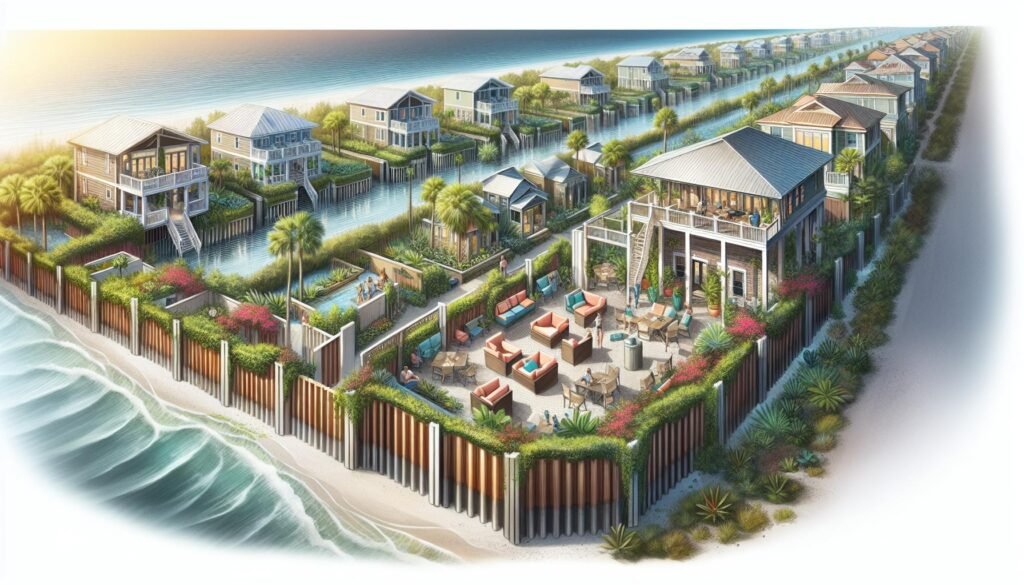Importance of Flood Zone Information
When I first considered moving to St. Pete Beach, the idyllic views and the promise of daily walks on the beach had me captivated. However, it didn’t take long for me to realize that living in paradise comes with its own set of challenges, particularly when it comes to understanding flood zones. Knowing your flood zone is not just a piece of trivial knowledge; it’s crucial for several reasons that I’ve come to understand firsthand.
Firstly, safety cannot be overstated. In areas prone to flooding, like St. Pete Beach, being aware of your flood zone means you’re better prepared for any eventuality. It’s not just about knowing when to evacuate; it’s also about understanding the risks involved in staying. This can be the difference between a safe retreat and a risky gamble with nature’s unpredictability.
Moreover, flood zone information impacts property ownership significantly. Here’s a quick rundown of what it meant for me:
| Aspect | Impact |
|---|---|
| Insurance Premiums | Living in a high-risk flood zone directly affects insurance costs, often leading to higher premiums. |
| Property Value | Homes in lower-risk zones tend to maintain or increase in value more reliably. |
| Renovation Restrictions | Some zones have specific regulations that can limit how and what you build. |
For anyone contemplating the purchase of a home in St. Pete Beach, these considerations are pivotal. They can influence not just your initial investment but also long-term expenses and property potential.
Additionally, with the ongoing concerns about climate change, flood zones are dynamic, not static. Areas that were once deemed low risk can gradually become high risk over time. Staying informed allows for better planning, both in terms of financial security and personal safety.
Understanding flood zone information has also made me a more engaged member of the community. It’s led to invaluable conversations with neighbors, participation in local planning meetings, and even involvement in community-led initiatives aimed at mitigating flood risks. This collective action and shared knowledge help foster a sense of camaraderie and resilience among residents, something that’s truly heartwarming in the face of nature’s adversities.
Types of Flood Zones in St. Pete Beach
Navigating the ins and outs of flood zones in St. Pete Beach has become a bit of a personal crusade for me. With the peculiarities of our local geography, understanding what each flood zone means can make a world of difference, especially when it involves making decisions about property purchase or insurance. So, let’s dive in and unpack the types of flood zones you’re likely to encounter in St. Pete Beach.
First off, it’s critical to grasp the distinction between the primary flood zone classifications here. You’ve got your AE zones, which are areas subject to inundation by the 1 percent annual chance flood event. Properties in these zones are considered at high risk. In St. Pete Beach, AE zones are pretty common due to our proximity to water bodies and the flat landscape. If your dream home falls in this category, you’re looking at mandatory flood insurance if you have a mortgage from a federally regulated or insured lender.
Then, there’s the VE zone, which takes it up a notch. Not only are these areas at risk of flooding, but they also face hazards from storm waves. Properties in VE zones are in the most vulnerable parts of St. Pete Beach, where the force of nature isn’t just about rising water, but also about the powerful waves that can cause significant damage.
For those thinking about a more relaxed approach to flood risk, X zones might sound appealing. These areas are considered to be at minimal risk compared to AE and VE zones. That said, it’s worth noting that “minimal” doesn’t mean “non-existent.” Living in an X zone means lower insurance premiums, but I always advise not to skimp on coverage. Mother Nature has a way of surprising us, particularly with the uptick in unexpected weather patterns over the past few years.
Here’s a quick glance at what we’re dealing with:
| Flood Zone | Description | Risk Level |
|---|---|---|
| AE | 1 percent annual chance flood event | High |
| VE | Coastal areas with additional hazards from waves | Very High |
| X | Areas of minimal flood risk | Minimal to Moderate |
Mapping Tools for Identifying Flood Zones
When considering the purchase or development of property in St. Pete Beach, it’s crucial to know exactly what you’re dealing with in terms of flood risk. Fortunately, there are various mapping tools available that can help you identify the flood zones in this area. I’ve spent a good amount of time exploring these resources and found them incredibly useful not only for property decisions but also for planning adequate flood insurance coverage.
One of the first places I turn to is the FEMA Flood Map Service Center. This online tool lets you enter an address, place, or coordinates to find flood maps. It’s straightforward to use, and best of all, it provides detailed information about flood zones, including whether a property falls within an AE, VE, or X zone. You can even download or print the maps for your records, which I’ve found to be quite handy for discussions with insurance agents or property developers.
Another great resource is the St. Pete Beach GIS (Geographic Information Systems) portal. This tool offers a wealth of information beyond just flood zones, such as zoning districts and property details. The flood zone layer on the GIS portal is particularly useful for getting a visual representation of how flood zones distribute across the area. I personally enjoy the interactive aspect of this tool because it allows me to zoom in and out, and get a clear picture of the specific risks associated with different parts of St. Pete Beach.
For those interested in more technical details, the Pinellas County Flood Information Tool is another invaluable asset. This tool goes beyond just identifying flood zones; it provides insights into base flood elevations, floodways, and historical flood data. I’ve found it particularly helpful for understanding the severity and frequency of flooding in certain areas. It’s a bit more complex to navigate than the FEMA or local GIS tools, but it’s well worth the effort for the depth of information provided.
It’s important to remember that these tools, while incredibly helpful, should be part of a broader approach to evaluating flood risks and insurance needs. I also recommend consulting with local experts and insurance professionals who can provide insights specific to St. Pete Beach. They can offer personalized advice that even the most detailed mapping tool cannot.
Regulations and Insurance in Flood Zones
When navigating the intricacies of living in or considering moving to a flood zone in St. Pete Beach, understanding the regulations and insurance requirements becomes paramount. It’s not just about knowing your zone; it’s about grasping what it means for your property and your wallet.
In flood zones like AE, VE, and X, regulations are designed to protect not only the individuals and properties but also the community at large from the potential devastation of flooding. For instance, buildings within AE and VE zones are required to have their lowest floors elevated above the Base Flood Elevation (BFE) to minimize flood damage. This might sound like a hefty requirement, but it’s a proactive step towards resilience against flood risks.
Let’s talk about insurance. Flood insurance in St. Pete Beach isn’t just recommended; in many cases, it’s required. If you have a mortgage from a federally regulated or insured lender and your property falls within a high-risk zone, then flood insurance is a must. However, even if you’re in a lower-risk zone, opting for flood insurance is a wise decision. Why wait until a disaster strikes to think about protecting your home?
Flood Insurance Rates
It’s crucial to note that flood insurance rates can vary significantly depending on several factors. These include your property’s location, its elevation, and the level of coverage you select. Here’s a simple breakdown:
| Zone | Average Annual Premium |
|---|---|
| AE | $700 |
| VE | $1,500 |
| X | $500 |
While these figures offer a broad view, the exact cost can be higher or lower, so it’s best to get a personalized quote.
A common misconception is that homeowners’ insurance covers flood damage. Unfortunately, this is rarely the case. That’s why getting flood insurance through the National Flood Insurance Program (NFIP) or a private insurer is critical. Not only does it provide peace of mind, but it also ensures that you’re not left struggling financially after a flood event.
The importance of adhering to local building codes and investing in flood insurance cannot be overstated. Together, they form a shield, protecting your property and your finances from the unpredictable nature of floods in St. Pete Beach. And while the regulations might seem stringent and the insurance a bit of a financial burden, they’re both invaluable in the long term.
Mitigation Strategies for Flood-Prone Areas
Living in a flood-prone area like St. Pete Beach means I’ve had to learn a bit about how to minimize potential damage from flooding. It’s not just about knowing your flood zone; it’s about taking proactive steps to protect my home and community.
One of the first things I did was look into elevating my property. This isn’t a small undertaking, but for homes in AE and VE zones, it’s a powerful way to reduce the risk of flood damage. By lifting the structure above the Base Flood Elevation (BFE), I’ve safeguarded my home against all but the most severe floods.
Another strategy I’ve found effective is installing flood barriers or shields. These can be as simple as sandbags placed strategically around entry points or as advanced as permanent barriers built into the landscape. They won’t stop all water from getting in, but they can significantly reduce the amount.
Then, there’s the idea of dry floodproofing. This involves making the building watertight below the level that floodwater is expected to reach. I’ve sealed the walls with waterproof coatings and installed valves to prevent sewage from backing up into my home. It’s an investment, but it brings peace of mind.
Wet floodproofing is an option I explored for areas of my home that aren’t easily made watertight. This method allows water to flow through the building, reducing pressure on structures and minimizing damage. It involves using materials that can get wet and installing electrical systems above potential flood levels.
I didn’t realize the impact landscaping could have until I started using native plants and vegetation to help absorb rainwater and reduce runoff. The roots create natural drainage paths, helping to keep water away from my home. Plus, it’s a great way to beautify the neighborhood.
Lastly, community engagement has been key. Working with neighbors to prepare for floods and sharing information about our flood zones helps everyone stay ahead of potential disasters. We’ve organized community clean-ups to keep drains and gutters clear, reducing the risk of water backing up during heavy rains.
- Elevating my property
- Installing flood barriers or shields
- Dry floodproofing my home
- Wet floodproofing vulnerable areas
- Using native plants for landscaping
- Engaging with my community
Conclusion
So there you have it. Living in a place as beautiful as St. Pete Beach comes with its own set of challenges, especially when it comes to flooding. But with a bit of preparation and the right strategies, we can protect our homes and our community. Whether it’s elevating our properties, installing flood barriers, or simply choosing the right plants for our gardens, every little bit helps. Let’s work together, stay informed, and make our neighborhood a safer place for everyone. After all, it’s not just about surviving the next big storm—it’s about thriving, no matter what Mother Nature throws our way.



